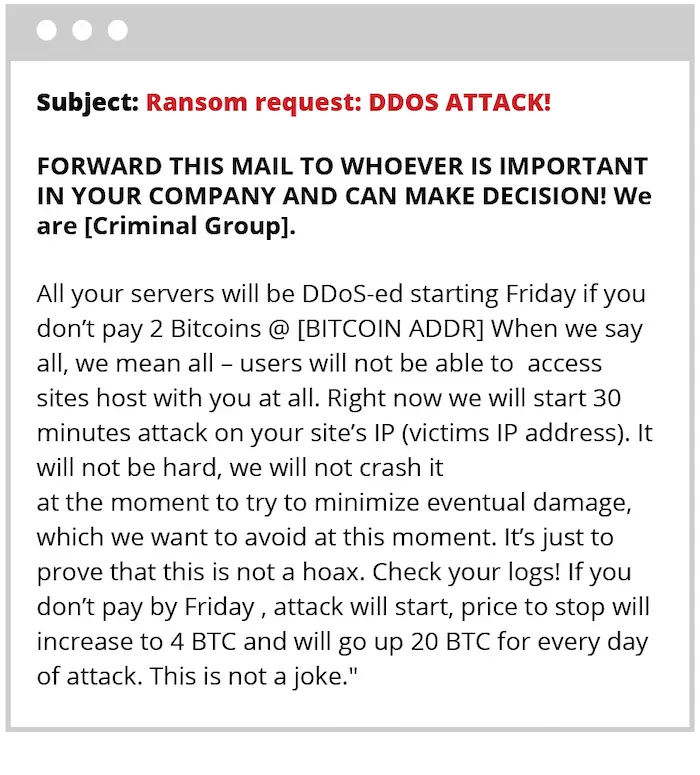What is Ransom Denial of Service
Ransom Denial of Service is when hackers ask you to pay them some money, threatening to launch a Distributed Denial of Service (DDoS) attack if you don’t pay up before a certain date and time. To show that they are serious about the RDoS attack, they may also launch a DDoS attack for a small period on the institution from who they are demanding the ransom. You might have also heard of ransomware: money asked by hackers after encrypting all data on any entity’s servers. In the case of Ransomware, hackers first encrypt an institutions’ data and then send a note to demand ransom saying they’ll decrypt the data AFTER they (the hackers) get the money. With RDoS, the note is sent PRIOR to any action on behalf of the hackers. It states clearly that the hackers have access to company servers, and they ask for a certain amount of money in Cryptocurrency (see Bitcoins) before a specific date. If money is not transferred to the hackers, they may proceed to encrypt the institution’s data or may leave it. The RDoS employs the fear of loss and helps the hackers as people pay up to avoid a DDoS attack. Since only fear is involved, amateur hackers too, start asking for money. They may or may not have resources to DDoS a company server but there’s no harm in demanding extortions, except the chances of being caught and sent to jail.
Should you pay up?
Experts say that you shouldn’t. They state that if even one institution pays the extortionist hackers, other hackers will also want to earn money. It will encourage other hackers and they too may demand a ransom (extortion money) saying they’ll DDoS the company servers if not paid. Experts also say that there is no guarantee that there won’t be a DDoS attack or a ransomware attack even if the extortion money is paid. Further, such acts will encourage other hackers. Should you let the hacker extortionists frighten you and pay them the money they are asking? No. It is always better to have a plan to counter such a scenario. The next section talks about how to prepare and deal with a DDoS attack. If you have a plan in place, you need not fear DDoS, RDoS, ransomware, or similar hacking issues. … but then again – it is a practical decision you will have to take seeing what is at stake for you!
RDoS – Precautions to prevent downtime when under attack
When a DDoS strikes after ransom demand, being prepared is key to stress-free handling of the situation. That’s why a DDoS protection plan is required. When planning a DDoS protection plan, assume that it is a common procedure – that is, it happens time and again. That way, you will be able to create a better plan. Some people create a Disaster Recovery Plan and use it to recover from a DDoS attack. But this is not our primary purpose. We need to mitigate the traffic flow to the company website or the website servers. For an amateur blog, a downtime of an hour may not mean much. But for real-time processing services – banking, online shops, and similar services – each second matters. That’s what you should keep in mind to create a DDoS Response Plan instead of a DDoS Recovery Plan. For your information, this website uses Sucuri to protect itself. Some of the important points to consider while creating a RDoS or DDoS attack are: This explains the Ransom Denial of Service (RDoS) and how to prepare for a DDoS attack. If you have anything to add, please comment below.
